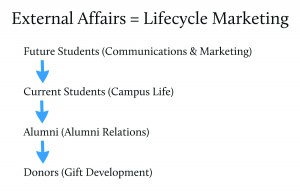Last week I attended the eduWeb Conference in Chicago. It was my second year going to the conference, and this time was especially enjoyable. Our university won an eduStyle People’s Choice Award, and we also had the opportunity to present.
Terry Flannery, executive director of communications and marketing at American University, delivered the opening keynote about “Building Your Brand on the Web and Managing to Make it Thrive.” Most interesting were her comments about the biggest challenges for institutions to deliver successful brand marketing in the digital age. She cited the following:
- Fear of loss of control
- Staffing
- Governance structure and span of control
- On-going training needs
- Morphing the university web presence to incorporate the brand strategy
- Keeping up with the next big thing
John Dalton and I presented “The Heretic’s Guide to Marketing to Millennials.” Our heretic’s guide touched on seven guiding principles and addressed many of the challenges posed by Dr. Flannery.
- Heretics challenge the status quo. (Please see my review of Tribes for more on this point.)
- Everything matters. Everything is marketing.
- Research, research, research.
- Everyone is on board. Everyone contributes.
- Top-level support makes all the difference.
- Integrate to innovate.
- Campus goals are our goals.
While I’d like to elaborate on and provide context for each of these, I’ll focus just on “Everyone is on board.” Throughout the conference we heard comments from others in attendance about “staffing, structure, and span of control” obstacles. Often this discussion dealt with the web being managed by IT instead of marketing, but it goes beyond that. At our university, our unit (External Affairs) is aligned to impact each stage of the lifecycle – from prospective student all the way to donor.
Two things, in my mind, make this approach unique. First, the top priority of our Office of Communications and Marketing is admissions marketing. That office has the pulse of prospective students through its constant teamwork with the Office of Admissions. Secondly, the Office of Campus Life is part of our External Affairs unit. Student activities and campus life are usually not considered part of the advancement effort. But keeping closely connected with current students through communications and events benefits our entire unit and ultimately the university.
Certainly it is easier to be structured this way at a smaller institution, but the bottom line is that “everyone is on board” and “everyone contributes.” There are no silos. No matter the audience (or the social web platform or the staff member), we are able to speak with one voice, with common goals, rowing in the same direction. As a result, we maximize integration and collaboration across the entire advancement function. This is invaluable.
Overall, there were several brand-related presentations at eduWeb, including BlueFuego’s Howard Kang with his high-energy “People vs. the Web: People Win! Truly Standing Out on the Social Web.” (Howard will also present at the CASE Indiana fall conference.) It’s so easy to fall into the institution-centric way of communications and marketing, but these sessions shared a variety of strategies for staying audience-centric.
Many thanks to the presenters, attendees, staff, and sponsors for making eduWeb 2010 a great conference.





